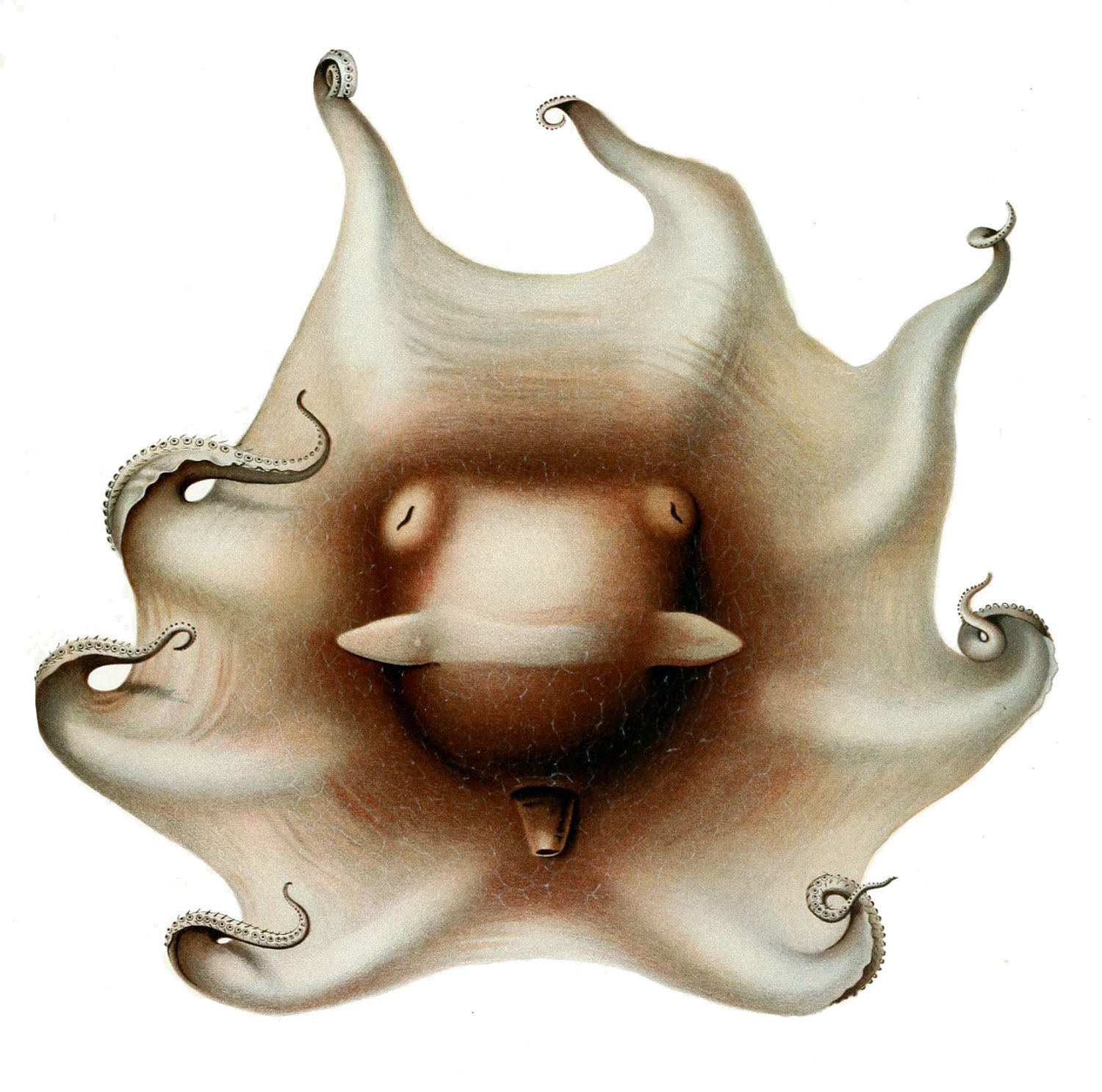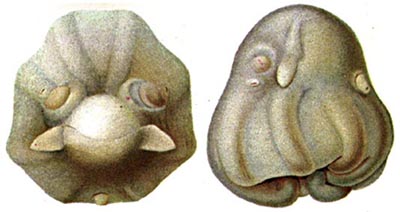|
Cirrata
Cirrina or Cirrata is a suborder and one of the two main divisions of octopuses. Cirrate octopuses have a Cirrate shell, small, internal shell and Cephalopod fin, two fins on their head, while their sister suborder Incirrina has neither. The fins of cirrate octopods are associated with a unique cartilage-like shell in a shell sac. In cross-section, the fins have distinct proximal and distal regions, both of which are covered by a thin surface sheath of muscle. The suborder is named for small, cilia-like strands (cirri) on the arms of the octopus, a pair for each sucker. These are thought to play some role in feeding, perhaps by creating currents of water that help bring food closer to the beak. Cirrate octopuses are noteworthy for lacking ink sacs, having reduced or absent radula, and reduced gills. The oldest known member of the group is ''Paleocirroteuthis'' from the Late Cretaceous of Japan and Canada. There is not much data about cirrate octopods due to their fragility, ma ... [...More Info...] [...Related Items...] OR: [Wikipedia] [Google] [Baidu] |
Grimpoteuthis
''Grimpoteuthis'' is a genus of pelagic Cirrina, cirrate (finned) octopods known as the dumbo octopus. The name "dumbo" originates from their resemblance to the title character of Disney's 1941 film ''Dumbo'', having two prominent ear-like fins which extend from the Mantle (mollusc), mantle above each eye. There are 17 species recognized in the genus. The Dumbo octopus has a gelatinous body and uses fin propulsion for movement, which also helps it to conserve energy in its extreme deep-sea environment. These unique physical traits distinguish it from other octopuses, which primarily rely on jet propulsion. Prey include crustaceans, bivalves, worms and copepods. The average life span of various ''Grimpoteuthis'' species is 3 to 5 years. Range and habitat Species of ''Grimpoteuthis'' are assumed to have a worldwide distribution, living in the cold, Abyssal plain, abyssal depths ranging from . Specimens have been found off the coasts of Oregon, the Philippines, Marth ... [...More Info...] [...Related Items...] OR: [Wikipedia] [Google] [Baidu] |
Cirrothauma Murrayi
''Cirrothauma murrayi'', the blind cirrate octopus, is a presumably blind octopus whose eyes can likely sense light, but not form images. It has been found worldwide, usually beneath the ocean's surface, but a single specimen was collected in the Arctic immediately below the sea ice. Like other cirrates, it has an internal shell, muscular fins for swimming, and a web connecting the arms. The species was first caught by an expedition led by Sir John Murray in 1910, and it was later named in honor of Murray. It was described by German marine biologist Carl Chun in 1911. The diet of this species is unknown, but like other cirrate octopods, the buccal mass, esophagus, and stomach of ''Cirrothauma murrayi'' suggest whole (but very small) organisms, especially small crustacean Crustaceans (from Latin meaning: "those with shells" or "crusted ones") are invertebrate animals that constitute one group of arthropods that are traditionally a part of the subphylum Crustacea (), a large, d ... [...More Info...] [...Related Items...] OR: [Wikipedia] [Google] [Baidu] |
Cirroteuthidae
Cirroteuthidae is a family of pelagic cirrate octopuses comprising at least five species in three genera Genus (; : genera ) is a taxonomic rank above species and below family as used in the biological classification of living and fossil organisms as well as viruses. In binomial nomenclature, the genus name forms the first part of the binomial s .... Description The cirrate octopods have a unique internal shell, positioned dorsally above the viscera and with a 'saddle-like' shape in ''Cirroteuthis'' (or 'butterfly-like' in ''Cirrothauma'' and ''Inopinoteuthis'' due to the anterior corners being more drawn out). The lateral faces of the 'saddle' acting as large attachment sites for fin muscles, supporting proportionally large and powerful fins. The arms are elongate and have both a primary web, forming most of the webbing, and a secondary web connecting the primary webbing to the aboral (outer) faces of each arm. The cirri, pairs of small finger-like projections between ... [...More Info...] [...Related Items...] OR: [Wikipedia] [Google] [Baidu] |
Cirroteuthis
''Cirroteuthis muelleri'', also known as the big-finned jellyhead, was the first cirrate octopus species (and genus) to be scientifically described (in 1836). It is closely related to the genus ''Cirrothauma'' within the family Cirroteuthidae. The species is restricted to the Arctic Ocean and far North Atlantic (specimens from the southern hemisphere and Pacific have been attributed to a new species '' Cirroteuthis kirrilyae'' Verhoeff & O'Shea, 2025).Vecchione, M. & R.E. Young 2003''Cirroteuthis'' Eschricht, 1836 The Tree of Life Web Project. Description ''Cirroteuthis muelleri'' can reach a maximum length of 400 mm (mantle length 170 mm). Statements that ''C. muelleri'' reaches up to 1.5 m total length are erroneous (and involve unidentified '' Cirrothauma'', then regarded as ''Cirroteuthis'' sp., being mistakenly assumed to be ''C. muelleri''). It is off white or pale purple, with the inner side of the arms and the webs being brownish-purple. The head has well devel ... [...More Info...] [...Related Items...] OR: [Wikipedia] [Google] [Baidu] |
Stauroteuthis Syrtensis
''Stauroteuthis syrtensis'', also known as the glowing sucker octopus or bioluminescent octopus, is a species of small pelagic octopus found at great depths in the north Atlantic Ocean. It is one of a very small number of octopuses to exhibit bioluminescence. Taxonomy The cirrate octopuses are deep sea species that have been relatively little studied. Some have been described on the basis of a single, poorly preserved specimen, and this makes deducing their phylogenetic relationships difficult. Some authorities adopt the traditional view that the genus '' Stauroteuthis'' is part of the family Stauroteuthidae that is characterized by the presence of a secondary web. The World Register of Marine Species, however, considers that it should be placed in the family Cirroteuthidae, basing this decision on ribosomal DNA and other evidence, and that Stauroteuthidae is a synonym of this family. Description The mantle length of ''Stauroteuthis syrtensis'' is about and its width about ... [...More Info...] [...Related Items...] OR: [Wikipedia] [Google] [Baidu] |
Opisthoteuthidae
Opisthoteuthidae, from Ancient Greek ὄπισθεν (''ópisthen''), meaning "back", and τευθίς (''teuthís''), meaning "squid", known as umbrella octopuses, are a group of pelagic octopuses. Umbrella octopuses are characterized by a web of skin between the arms, causing them to somewhat resemble an opened umbrella when the arms are spread. Description Opisthoteuthidae are a group of octopuses characterized by a web of skin in between their arms. They broad U-shaped shell that support muscles for a pair of small fins on the mantle, these fins are far less developed than other families in Cirrina and essentially only act as stabilizers when the animal swims (using a medusoid motion of the arms and webbing). This structure makes the umbrella octopus resemble an umbrella when they spread their arms/web out. The structure of the umbrella octopus has the oral surface below the mantle of the octopuses and the web with their arms surround the bottom of the mantle. Their oute ... [...More Info...] [...Related Items...] OR: [Wikipedia] [Google] [Baidu] |
Cirrate Shell
Cirrate octopuses possess a well-developed internal shell that supports their muscular swimming fins. This is in contrast to the more familiar, finless, incirrate octopuses, in which the shell remnant is either present as a pair of stylets or absent altogether. The cirrate shell is quite unlike that of any other living cephalopod group and has its own dedicated set of descriptive terms. It is usually roughly arch- or saddle-shaped and is rather soft, being similar in consistency to cartilage. Each of the eight extant cirrate genera is characterised by a distinct shell morphology outlined below (below taxonomy updated per WoRMS): *Superfamily Cirroteuthoidea ** Cirroteuthidae ***'' Cirroteuthis'' — saddle-shaped, with large wings ***'' Cirrothauma'' — butterfly-shaped ** Stauroteuthidae ***'' Stauroteuthis'' — U-shaped *Superfamily Opisthoteuthoidea ** Opisthoteuthidae ***'' Opisthoteuthis'' (also '' Exsuperoteuthis'' & '' Insigniteuthis'')— U-shaped, lateral wings usu ... [...More Info...] [...Related Items...] OR: [Wikipedia] [Google] [Baidu] |
Umbrella Octopus
Opisthoteuthidae, from Ancient Greek ὄπισθεν (''ópisthen''), meaning "back", and τευθίς (''teuthís''), meaning "squid", known as umbrella octopuses, are a group of pelagic octopuses. Umbrella octopuses are characterized by a web of skin between the arms, causing them to somewhat resemble an opened umbrella when the arms are spread. Description Opisthoteuthidae are a group of octopuses characterized by a web of skin in between their arms. They broad U-shaped shell that support muscles for a pair of small fins on the mantle, these fins are far less developed than other families in Cirrina and essentially only act as stabilizers when the animal swims (using a medusoid motion of the arms and webbing). This structure makes the umbrella octopus resemble an umbrella when they spread their arms/web out. The structure of the umbrella octopus has the oral surface below the mantle of the octopuses and the web with their arms surround the bottom of the mantle. Their oute ... [...More Info...] [...Related Items...] OR: [Wikipedia] [Google] [Baidu] |
Stauroteuthis
''Stauroteuthis'' is a genus of deepwater cirrate octopus, a cephalopod mollusk. This is the only genus in the family Stauroteuthidae, and only three species have been described in this genus. The organisms live below water depth; although sometimes found as deep as underwater, they generally live at a water depth of around . They do not possess a radula. The stauroteuthids have the distinction of being one of the few bioluminescent octopuses; some of the muscle cells that control the suckers in most species have been replaced with photophores which are believed to fool prey by directing them towards the mouth. Species * ''Stauroteuthis gilchristi'' (Robson, 1924): Known from two localities in the south Atlantic, and other southern ocean locations (Macquarie Island, and Kerguelen). * ''Stauroteuthis syrtensis'' Verrill, 1879: Widespread in the North Atlantic. The population size of ''S. syrtensis'' is unknown. [...More Info...] [...Related Items...] OR: [Wikipedia] [Google] [Baidu] |
Cirroctopus
''Cirroctopus'' is a genus of four species of octopuses within the monotypic family Cirroctopodidae. Members of this genus have larger fins than other cirrate octopuses, and tend to be more muscular.Vecchione, Michael and Richard E. Young. 2016. Cirroctopodidae Collins and Villanueva 2006. Cirroctopus Naef, 1923. Version 27 February 2016 (under construction). http://tolweb.org/Cirroctopus/20103/2016.02.27 in The Tree of Life Web Project, http://tolweb.org/ They are found in the southern hemisphere, where they live at depths of over 300m. References Octopuses Taxa named by Adolf Naef {{octopus-stub ... [...More Info...] [...Related Items...] OR: [Wikipedia] [Google] [Baidu] |
Grimpoteuthidae
Grimpoteuthidae are a family of bentho-pelagic octopuses, comprising three currently accepted genera. They have extensive arm webbing and relatively large fins allowing for powerful fin swimming. Description Grimpoteuthidae have a strongly U-, V-, W-shaped internal shell (gladius remnant) that supports muscles for large fins. These fins are proportionally much larger than in the related Opisthoteuthidae, and allow for much stronger swimming using the fins alone (unlike Opisthoteuthids that mostly use the arm webbing for swimming). Unlike Cirroctopodidae and Opisthoteuthidae, Grimpoteuthids also have the optic nerves heading to each eye as a single bundle (in the other families this occurs as multiple separated nerve bundles). The extensive arm webbing is shared with Opisthoteuthidae and Cirroctopodidae. Taxonomy The following genera and 19 species are currently accepted in this family. The family has consistently been supported in molecular studies as distinct from Opistho ... [...More Info...] [...Related Items...] OR: [Wikipedia] [Google] [Baidu] |




